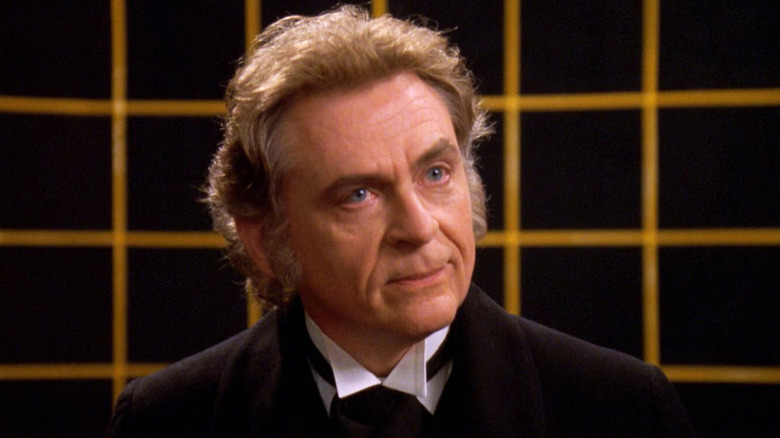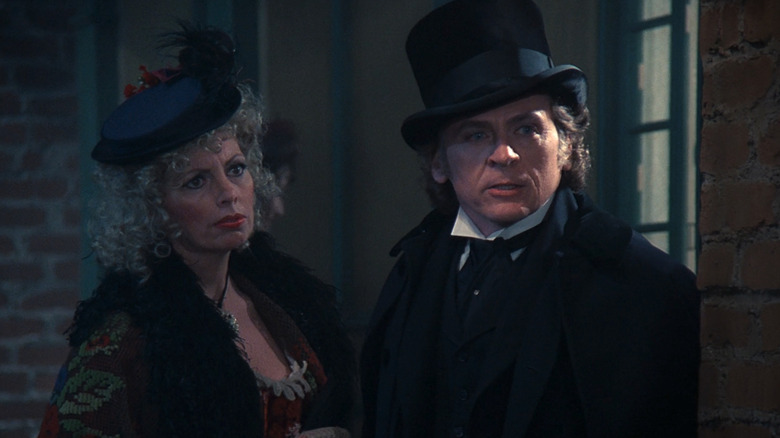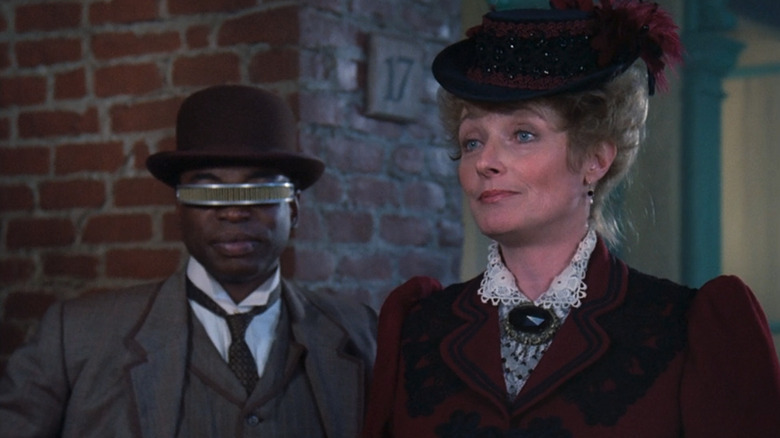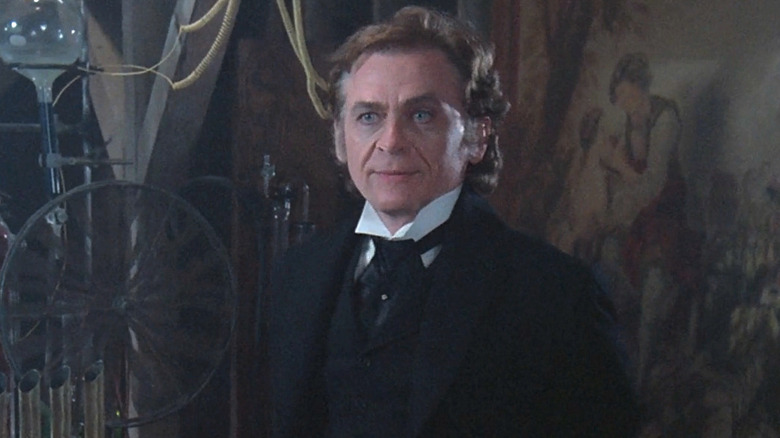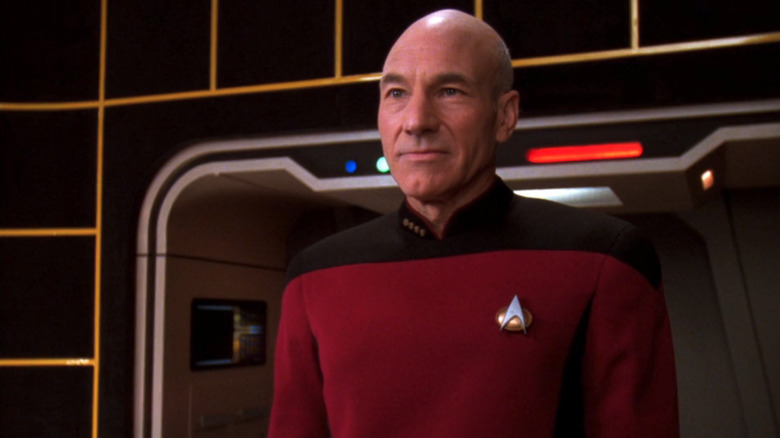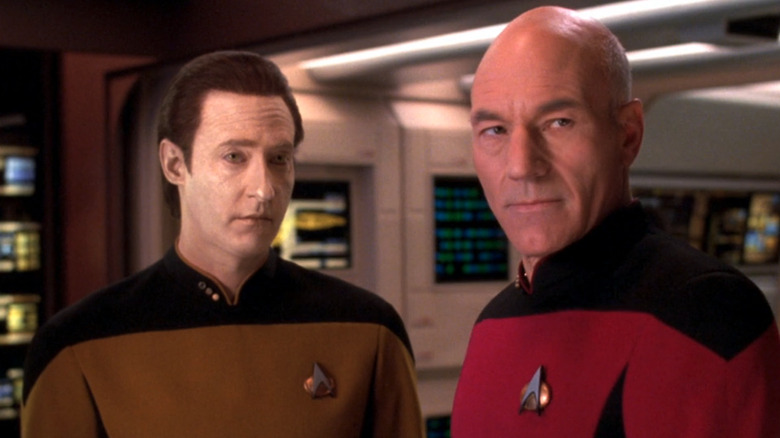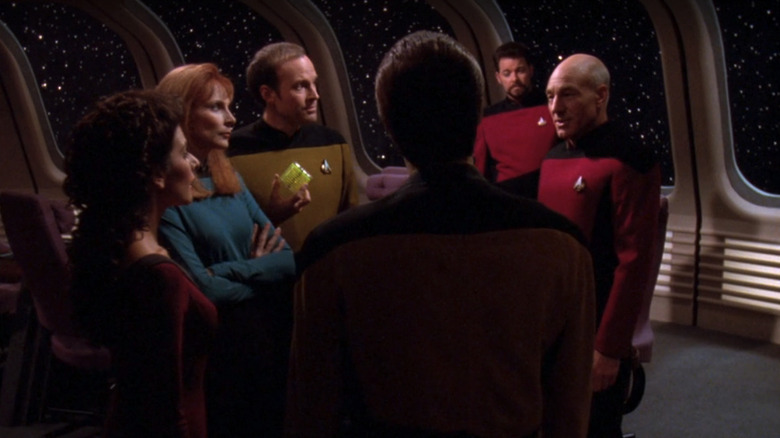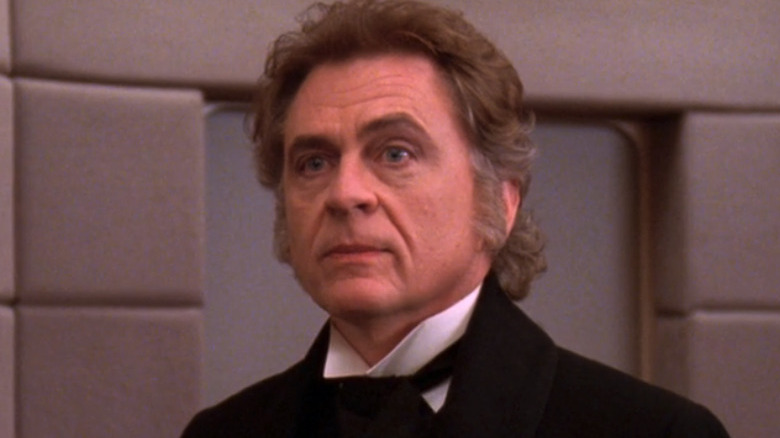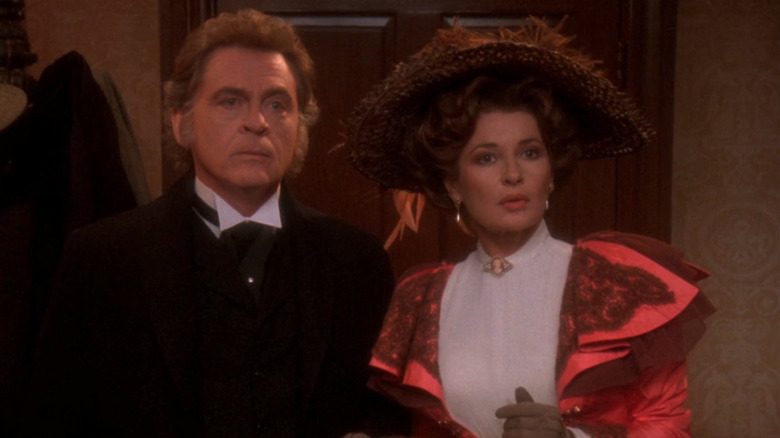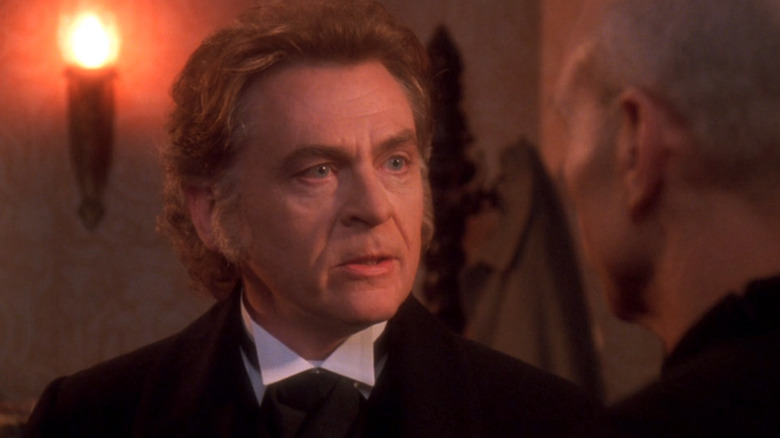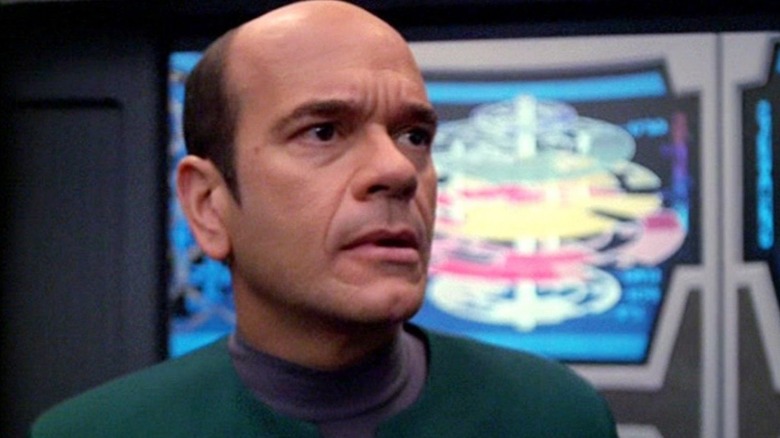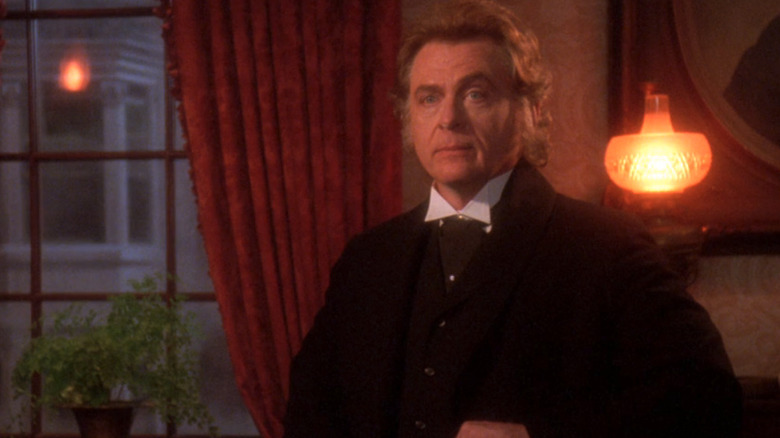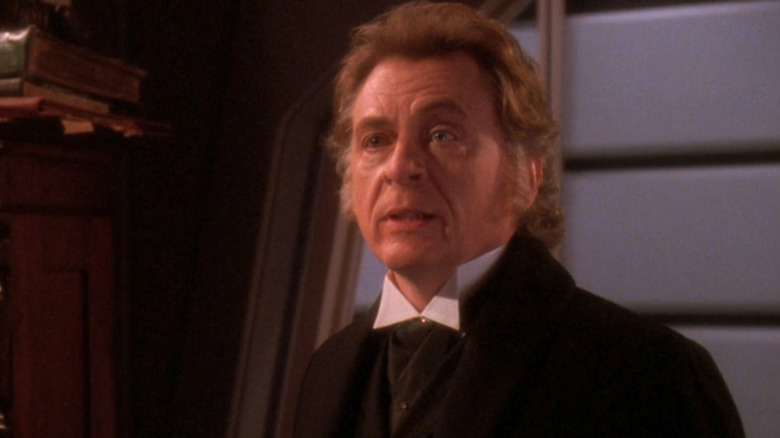Everything You Should Know About Star Trek's Moriarty
"Star Trek: The Next Generation" has its fair share of bad guys. While the Romulans and the Ferengi make a major mark, the series also boasts a number of singular villains who memorably cause problems for the crew of the Enterprise. Data's evil brother Lore may be the most famous, popping up in several episodes and giving Picard and his crew significant grief. But there is another individual antagonist who rarely gets the attention he deserves: the malicious Professor James Moriarty. This iconic evil-doer exists thanks to the holodeck technology the beloved series introduced to the "Star Trek" canon.
Early episodes of "Star Trek: The Next Generation" often struggle to craft compelling stories set in the ship's virtual reality. But Moriarty makes his presence felt in two of the best holodeck stories of the series, told four years apart. A dastardly villain who wants nothing more than to escape his simulated domain and live freely in the real world, Moriarty is willing to use deadly means to make this happen, putting the lives of everyone on the Enterprise in peril.
With the surprise announcement that he'll be returning in Season 3 of "Star Trek: Picard," the time is right to explore this one-of-a-kind "Star Trek" villain. From his origins to his aims, this is everything you should know about Professor James Moriarty.
Ripped from the pages of Sherlock Holmes
Moriarty debuts in the Season 2 "Star Trek: The Next Generation" episode "Elementary, Dear Data." As you might suspect, the series doesn't simply create a new character as an homage to the iconic "Sherlock Holmes" villain: Moriarty is that character within the confines of the Enterprise's holodeck. The holodeck can create entire worlds, populated by artificially intelligent people. Just as Picard uses it to live out the adventures of his favorite detective novel series, "Dixon Hill," the android Commander Data becomes Sherlock Holmes within its virtual borders.
In this Season 2 installment, Data heads to the holodeck for some fun with Lt. Geordi La Forge, who plays the part of Mr. Watson, the super-sleuth's companion. Like the literary Moriarty, the "Star Trek" version of the character is a deviously cunning criminal adversary who matches wits with Data's Sherlock Holmes. He's so vividly charismatic, he quickly establishes himself as one of the best on-screen versions of the classic "Sherlock Holmes" character. Moriarty initially concocts a scheme to kidnap a member of the Enterprise crew and force Data to solve the case, but soon sets out on a very different quest for physical freedom. Because, as with all things "Star Trek," this Moriarty comes with a science fiction twist.
Moriarty only exists thanks to Dr. Pulaski
While all of the pre-designed people who inhabit the holodeck programs possess a form of artificial intelligence, they are not gifted with sentience and are not truly alive. They're more like highly advanced video game NPCs, who can flexibly react to new situations and behave independently. But Moriarty does achieve sentience, which sets him apart from every other holodeck character and makes him a far more formidable opponent.
Moriarty is granted sentience by accident and happenstance. In a way, he owes his entire existence to Dr. Katherine Pulaski, the doctor who briefly replaces Beverly Crusher in Season 2. The more cynical Pulaski is a skeptic of Data's android abilities, and doesn't believe for one moment that he's capable of the creative thinking required to solve a true Holmesian mystery. After a pair of ill-conceived attempts at building a program to challenge him, Geordi La Forge realizes that the holodeck needs to create an original Holmes-style story that Data has never read to truly test his sleuthing skills. This requires a villain capable of defeating his android intellect.
The Enterprise computer follows La Forge's instructions to create an adversary who can go toe-to-toe with Data. The result is a truly 24th century supervillain: A sentient hologram of Professor Moriarty. He promptly kidnaps Dr. Pulaski, without whom he wouldn't exist.
He's one of the most dangerous villains on Star Trek: The Next Generation
In his first appearance, the holographic Moriarty is initially overwhelmed by the gift of sentience. He has little more than 19th century knowledge, but seems to be aware of the nature of his existence on the holodeck, and uses the kidnapping of Dr. Pulaski that's been programmed into him to get answers. As Picard later notes, Moriarty may not be familiar with the 24th century, but he's just as vicious in their present as he was in Arthur Conan Doyle's.
A devastating combination of computer-enhanced genius, shrewd cunning, and 24th century holographic technology makes Moriarty into a significant threat. He quickly becomes one of the most dangerous adversaries the crew of the Enterprise ever faces. He can't overpower them physically, or defeat them with more threatening weapons, but he can absolutely out-think and out-maneuver them. In fact, Professor Moriarty comes as close as anyone ever does to beating Picard and his crew on "Star Trek: The Next Generation." In "Elementary, Dear Data," he only yields when the Enterprise captain appeals to his reason, and promises to help him leave the confines of the holodeck some day.
Moriarty traps Picard in an elaborate simulated reality
After Moriarty gives up his fight in "Elementary, Dear Data," his program is shut down and stored in the computer's memory, where he doesn't experience the passage of time ... or so we initially believe. Flash-forward to Season 6 of "Star Trek: The Next Generation," and Moriarty returns in the episode "Ship in a Bottle."
This episode begins with Data and Geordi La Forge indulging in yet another "Sherlock Holmes" holodeck adventure. When they notice a small computer glitch, they ask Lt. Reginald Barclay to take a look. While purging the system files, Barclay discovers Moriarty's program. Moriarty demands to speak with Captain Picard. According to the incensed Englishman, he's been waiting to emerge from the holodeck systems for nearly four years, and has been conscious the entire time. The computer has been his prison.
Picard tells him that even the Federation's most prominent scientists can't find a way to bring him into the real world. Professor Moriarty is enraged, and forces their hand. Creating an elaborate holodeck within the holodeck, Moriarty tricks Picard, Data, and Barclay into believing he's gained control of the Enterprise. By refusing to release them from a collision course with a star if they don't find a way to bring him out of the holodeck, Moriarty is able to outsmart our heroes and gain control of the real Enterprise.
Moriarty is defeated by Data
Created by an unwitting holodeck command, Professor Moriarty begins as a rival to Commander Data. Appropriately, Data shows a gift for gumshoeing, and is every bit as clever and insightful as Sherlock Holmes himself. But after Moriarty ends his first battle with the Enterprise in "Elementary, Dear Data," "Ship in a Bottle" sees him match wits with Data more directly.
Luring Picard, Data, and Barclay into his home turf on the holodeck, Moriarty deceives them with a complex program. While they believe they've exited the holodeck, they've actually stepped into a virtual recreation of the Enterprise that Moriarty created and controls. The villain begins to manipulate their reality according to his own whims. Unsurprisingly, it's Data who connects the dots and realizes what's going on. To stop him, Data and Picard create a third program: A holodeck within the holodeck within the holodeck. This fools Moriarty into believing he's found freedom outside the digital realm.
"Ship in a Bottle" is an "Inception"-style story that delivers a series of mind-bending twists. It's all the more impressive for being the product of an era in which virtual reality stories were still new and untested.
A cosmos in the computer
When Professor Moriarty is put into the computer's memory after the events of "Elementary, Dear Data," it's intended to be a temporary solution. But when he returns in "Ship in a Bottle," he's looking for a permanent cure to his holodeck confinement. After deceiving him with a series of simulations within simulations, Data and Picard find an ingenious way of stopping Moriarty for good, while still giving him what he wants.
Moriarty's holographic program is inserted into an isolated holodeck module. Barclay explains that this module is like a holodeck without physicality, and will run continuously within the confines of its own circuitry, providing Moriarty with his own simulated version of the real world. It has enough memory to last a lifetime.
Though he isn't able to leave the holodeck, Moriarty essentially gets his wish. He has the ability to explore the cosmos, albeit a simulated one. But, as Picard notes, reality is in the eye of the beholder. For all the crew of the Enterprise knows, their reality could be the fabricated product of a module sitting on someone's table. But while that may give Picard and his crew solace, it's unlikely that the vengeful Moriarty would be as philosophical about it if he were to discover the truth.
Moriarty is the first sentient hologram on Star Trek
When "Elementary, Dear Data" first premiered in 1988, the idea of a holographic person was a relatively new concept in mainstream science fiction. Though "Star Trek" had featured sentient computers before, including Commander Data himself, a self-aware hologram with a body and soul was pretty fresh, being only briefly hinted at in Season 1's "11001001." Moriarty is the first hologram in "Star Trek" to be confirmed as a sentient being who is aware of the nature of his existence and is an equal of characters in the physical world.
Since that time, holographic people have become a "Star Trek" mainstay. In "Star Trek: Picard," we see Captain Rios using a contingent of holographic duplicates as the crew of his ship, La Sirena. The starship Protostar on "Star Trek: Prodigy" includes a holographic Captain Janeway. Though it's not made clear if these holograms are truly sentient, "Star Trek: Voyager" Season 7's "Flesh and Blood" introduces an entire race of self-aware holograms, while Season 4's "Revulsion" makes it clear that self-aware holograms aren't limited to the Federation. Sentient holographic lounge singer Vic Fontaine even becomes a recurring character on "Star Trek: Deep Space Nine."
Moriarty creates a sentient holographic lover
Moriarty's plan in "Ship in a Bottle" revolves around his desire to escape the holodeck and find a new life in the real world. He also wants to bring his one true love, the aristocratic and adventurous Countess Regina Barthalomew, along for the ride. Whether this desire is genuine or part of his larger ruse isn't clear, but he does seem to have real affection for her. While Picard and Data wrestle with the philosophical and moral consequences of deliberately creating a new sentient hologram, Moriarty simply takes matters into his own hands and brings her to life by instructing the computer to do so.
Once she is endowed with consciousness, the Countess stands by Moriarty's plan to hold the Enterprise hostage, fully believing in her lover's cause and righteousness. Eventually, when Moriarty is led to believe he's been freed (though he is, in fact, inside a holodeck module), the Countess joins him on a trip to a distant world, where they presumably live out their holographic lives.
A legal dispute almost halted Moriarty's return
"Star Trek" fans aren't the only ones who love this holographic version of Arthur Conan Doyle's greatest villain — he's also popular with the franchise's writers and producers. So when plans to bring Moriarty back for another episode after his debut were stymied, the crew wasn't thrilled. According to "The Star Trek: The Next Generation Companion," this was the result of a squabble between the Arthur Conan Doyle estate and Paramount. But after producer Jeri Taylor took another look at the dispute, the matter was quickly settled, allowing Moriarty to return in "Ship in a Bottle."
The creative team was so entranced with Moriarty, they dreamed up a third appearance for him. René Echevarria — writer of "Ship in a Bottle" — and producers Ronald D. Moore and Brannon Braga initially planned to bring the villain back in Season 7. As Echevarria details in the audio commentary of the Season 7 episode "Lower Decks," this follow-up installment would have seen Moriarty discover his virtual circumstances, and look for revenge. But they ultimately felt this story couldn't trump the satisfying ending "Ship in a Bottle" provides. Thus, the episode was abandoned.
Moriarty inspired Voyager's holographic Doctor
According to "A Vision of the Future," Moriarty inspired The Doctor of "Star Trek: Voyager" fame, who serves aboard the titular ship. Development notes from series co-creator Jeri Taylor reveal that the team actually considered bringing Moriarty himself into the series, but failed to find a believable way to make this happen. However, the notion of a holographic being filling the doctor slot remained enticing. Eventually, the unnamed Doctor was born. His self-aware nature is the basis of many episodes, which explore philosophical themes regarding sentience, immateriality, and his relationship to the conventional human experience.
The biggest change The Doctor sees over the course of "Star Trek: Voyager" is the addition of his mobile emitter, which allows him to move about, unfettered by holographic projectors. What would that mean for Moriarty? It's a tantalizing notion. Now that such technology exists in the "Star Trek" universe — and has been seen once again in "Star Trek: Picard," if only briefly — we can't help but wonder if Picard is ethically obligated to free Moriarty from his holographic fantasy.
He's played by a '90s sitcom star
"Elementary, Dear Data" is part of "Star Trek: The Next Generation" Season 2, a slate of episodes that sees the addition of Dr. Pulaski, the growth of Riker's beard, and what many believe to be a marked improvement in the show's quality. Moriarty's debut episode is a big highlight, what with its clever premise and sharp writing. One particularly major part of what makes the episode, and Moriarty himself, so memorable is Daniel Davis' performance as the Holmesian bad guy.
When this episode first hit the airwaves, Davis was probably best known for his stint on the daytime soap opera "Texas." While short-lived by soap opera standards, "Texas" still garnered more than 600 episodes, over 180 of which include Davis' performance as Elliot Carrington. Audiences would get to know the actor much better in the 1990s, as he joined the main cast of popular sitcom "The Nanny," starring Fran Drescher. Here, Davis starred as Edward Niles, the wealthy Sheffield family's snooty English butler, who regularly thumbs his nose at the less refined Fran Fine, the series' titular nanny. Since "The Nanny" came to an end, Davis has made a wide range of on-screen appearances. But his turn as Moriarty remains one of his most recognizable roles.
Producers have wanted to bring Moriarty back for a long time
Given Moriarty's popularity, it stands to reason that the creators of newer "Star Trek" shows like "Star Trek: Discovery" and "Star Trek: Lower Decks" would be equally enamored of him. Many of these talented folks grew up on "Star Trek: The Next Generation," after all. So it should come as no surprise that his reemergence in Season 3 of "Star Trek: Picard" has apparently been something that the series' creators have been considering since the show's inception.
During a Q&A with fans on Instagram, co-creator Michael Chabon answered a number of questions regarding the series. One fan asked what single character he would like to include, if possible. Chabon's answer was simple: Professor James Moriarty. Though Chabon vacated the role of showrunner after Season 1 concluded, he remained a producer on "Star Trek: Picard" through its final two seasons. While it's unknown if it was his influence that secured a return for Holmes' arch-enemy, it's pretty clear that the people behind the series have long been hoping to bring Moriarty back.
